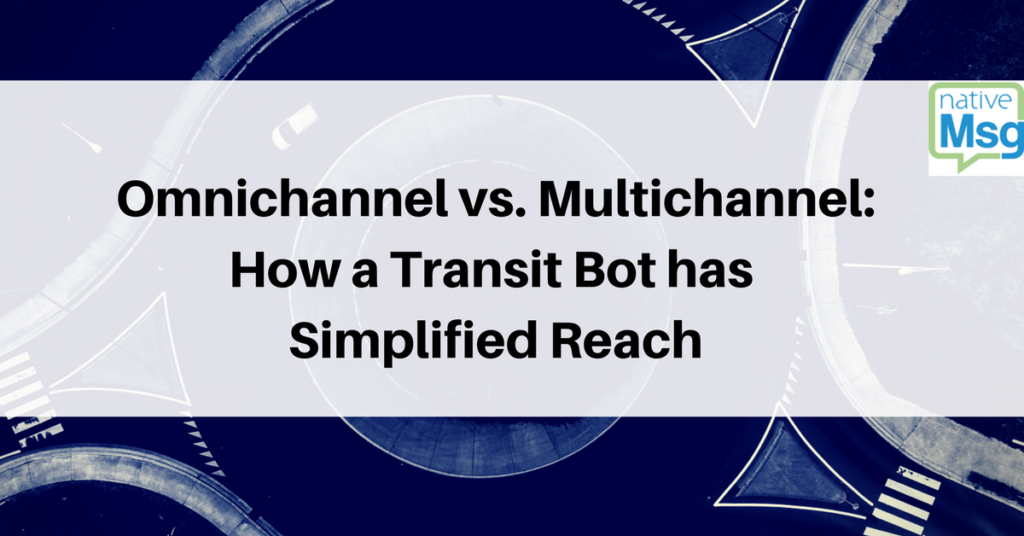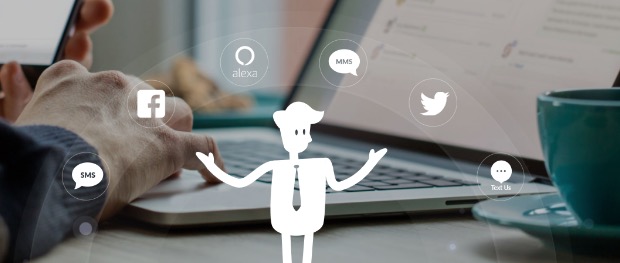
In the last year, omnichannel vs. multichannel marketing sounds like the new buzzword for what is just multichannel marketing.
But, it really is a different approach and it’s largely because of the tech that enables it. Chatbots within messaging channels play a large part in this approach. Omnichannel reach is a more productive way to reach customers for everyone. It’s also more customer-centric.
Here’s how to think about omnichannel vs. multichannel, what to know for your business and where omnichannel is heading in the near future.
First, Clarify “Channel” Marketing
There’s alot of confusion around “multi” and “omni” channel marketing so it’s important to clarify how we talk about the term channel in the first place. Let’s address that from the start.
Distribution channel
Historically, a channel is a means of distributing your product, a distribution channel, from manufacturer to distributor, or manufacturer straight to consumer.
Purchase channel
Then, how is a product physically purchased? Does a consumer travel to the space, or does the product travel to the consumer? (Think mail-order catalogue as opposed to in-store purchase). This is the purchase channel.
Communication channel (Marketing channel)
Finally, the communication channel is how and where your customers find out about your product.
Take a Page from History
A Sears-order catalogue may sound like a quaint by-gone marketing and purchasing channel, but the innovation in access was an important evolution in the marketing channel strategies available today.
While other businesses offered a mail-order catalogue, Sears took things a step further. They offered a catalogue of “The Best Bargains.” Sears increased distribution to meet the fast changing spring and fall fashions, offered additional catalogues for specific products and delighted customers with handy additions like “Wish Lists” and extras like eye tests with a pair of eyeglasses. It’s one of the first fantastically successful examples of multi-channel strategy.
Want to learn more about hybrid chatbot solutions for your business? Start here: Best Chatbot to Human Customer Service Solutions for StartUps, Retail and Travel.
Channels Have Intersected, But Integration Has Lagged
With the explosion of e-commerce and social media, when you hear the term channel, it’s not a one-size fits all term for purchasing and marketing. Likewise, “purchasing” is a customer-centric experience that has morphed into the “sales” channel, which focuses on business profit.
This is the crux of why omni and multichannel marketing have become confusing. Both purchasing and marketing need to be accurately addressed. Every marketing channel today can lead to a real-time purchase, no matter the channel. Without a comprehensive, vigilant approach to consistency, multiple channels to do so can create disconnects.
Mailers, television and phone marketing are all marketing channels that have been around for some time. But the digital experience created a hyper-focus on channel marketing because of the larger reach within social media and the real-time purchase access across these channels.
How Multichannel Marketing Has Worked
Multichannel has meant that businesses provide multiple channels as a way for consumers to reach out on the channel they’re most likely to interact on. It’s a diversification that almost always includes:
- Website
- Social Media
- Phone
And, it’s a lot of hustle. As any marketing team will relay, it’s covering a lot of moving targets, at times, and fine-tuning your reach to convert warm leads. Omnichannel refines this approach to better integrate ease of access and ease of marketing.

What Omnichannel Marketing is Now
Think for a moment about a person you know who always provides you with simple, short, clear answers. Maybe it’s a colleague, a relative, or your auto-mechanic. You come to trust it’s just an easy, fast, no-hassle way to get an answer.
The person has created a gravitational dynamic that attracts others, too, for the same reason. You’ll call them on the phone, text them, go to them in person, whichever makes most sense for you, but you know two very important things:
- You know how to easily access this person and where, no matter the medium.
- You know you’ll get the same fast access, simplicity and information no matter the medium.
It organizes information and access around the customer’s ease. That’s what’s most important here and differentiates omni from multichannel marketing.
Omnichannel marketing is an approach that grooms consumers to expect that there are multiple, consistent access points to information and purchasing, and each channel offers the same ease of experience.
What are the Key Differences Between Omnichannel Vs. Multichannel?
But one of the differentiating components is intelligent analytics and platforms that track touchpoints and respond with a more personalized ad, communication or offer. Conversational AI is a tool to integrate these channels for a seamless experience.
Once, there were floppy disks and consumers needed to save information to one or save it directly to a computer. With the proliferation of cloud services, access is easier, accessible and consistent. Omnichannel marketing works similarly.
Omnichannel Marketing Vs Multichannel Marketing
| Omnichannel | Multichannel |
| Offers ubiquity in purchase access | Purchase is channel-centered |
| Consistent personalization with integrated messages across channels | Different marketing approach per channel |
| Ubiquity in placement of marketing messages, many times supported by conversational and AI analytics | Amplification of message for increased awareness |
The Benefits of Omnichannel: Why nativeMsg Launched the ChiTransitBot

Recently, nativeMsg launched a free chatbot service for Chicago commuters.
There’s one important value proposition: ease of access and responsiveness. The Chicago Transit Bot is an example of how purchasing (or here, adoption rates) and marketing can cross. It’s offered on social media and onsite. It provides a needed service and a fast, correct answer for busy commuters. Commuters may access it at different points (Facebook vs. Twitter), but the information and experience is the same.
The benefits of omnichannel with conversational AI are many for both businesses and consumers. Marketers no longer need to twist themselves into the proverbial pretzel. Instead, conversational AI creates one access point to all channels and is integrated across these channels.
Your customer knows he can access the same simple steps and info no matter on email, site, social or phone. He knows he can find the same information and that each channel will bring him more precisely to the information he needs:
- Social ads can direct back to first interest search queries and can be automated to then create incentivized ads as a result.
- Also, there’s no waiting around for a customer service rep to find your info. Instead, he can pick up where you left off on your research or purchase steps.
- Instead of tracking siloed channels, conversational AI offers cohesion in real-time analytics for more personalized tracking in customer engagement across social, site or email channels.
- It creates less work on both ends. You’re tweaking across channels to the same access point and the messaging is uniform around personalization. Your customer can sense this and this builds trust in service.
A Channel-Less Future
The real implication of omnichannel strategy supported by AI is that the future is channel-less. More and more, omnichannel marketing strategies and conversational AI tech are going to be intertwined to offer a channel-less experience.
Messaging as a Platform (MaaP) for this is the foundation. It means consumers and businesses will be able to access this uniform experience via the messaging superhighway with conversational AI. Positioning your business within messaging channels now is a way to smooth the entry process into a solid omnichannel marketing approach and for the future of digital marketing.
Check-out how to create an effective conversational layer for your business by starting here ,and get in touch with nativeMsg for a consultation.
Free Trial
Get Started With RCS
Business Messaging!
Unlock the power of RCS and revolutionize your customer engagement.



